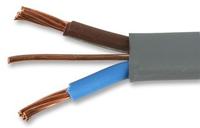Hello everyone on the forum.
Imagine this situation:
From the switchboard on the first floor of the house is run a wire to the box in the attic. In the switchboard it is protected by a B32 fuse. It is a wire of the type YDYp, wire. I estimate the cross-section to be 6mm2. On the other hand, from the garage to the same box in the attic is led reinforced cable 3x2.5mm². I know that the fuses in the switchboard in the house should be adjusted to the weakest wire, which means replacing the fuse from B32 to B16. But I also know that it is necessary to additionally protect the connection of cables with different cross sections. How should this be done? Will putting an additional switchboard in the garage be a good solution?
Imagine this situation:
From the switchboard on the first floor of the house is run a wire to the box in the attic. In the switchboard it is protected by a B32 fuse. It is a wire of the type YDYp, wire. I estimate the cross-section to be 6mm2. On the other hand, from the garage to the same box in the attic is led reinforced cable 3x2.5mm². I know that the fuses in the switchboard in the house should be adjusted to the weakest wire, which means replacing the fuse from B32 to B16. But I also know that it is necessary to additionally protect the connection of cables with different cross sections. How should this be done? Will putting an additional switchboard in the garage be a good solution?



